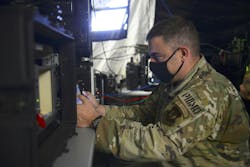Air Force taps Northrop Grumman for missile defense battle management in aircraft and missile tracking
REDSTONE ARSENAL, Ala. – Command and control experts at Northrop Grumman Corp. are upgrading and maintaining two battle management systems for the government of Poland to help military authorities quickly deal with uncertain information concerning potential air and missile attacks.
Officials of the U.S. Army Contracting Command at Redstone Arsenal, Ala., announced a $9.7 million order earlier this month to the Northrop Grumman Mission Systems segment in Huntsville, Ala., for work two complete battery sets of Integrated Air and Missile Defense (IAMD) Battle Command System (IBCS) production hardware and software for Poland.
The IAMD IBCS is the command-and-control segment of Poland's Patriot air-defense missile forces. Northrop Grumman originally won a $349.4 million contract in March 2019 to build the system.
The IBCS is a revolutionary air command-and-control (C2) system to help air and missile defenders make quick decisions and adapt quickly to changing battlefield conditions.
Aircraft and missile tracking
The IBCS will help enhance aircraft and missile tracking and situational awareness to enable military commanders and air defenders in Poland to make critical decisions within seconds in response to air and missile attacks, Northrop Grumman officials say.
Northrop Grumman has built IBCS engagement operations centers and integrated fire-control network relays, and delivered IBCS network-enabled command and control for four firing units.
The IBCS engagement operations centers are integrated with IBCS battle management software that makes the most of the combat potential of sensors and weapon systems, Northrop Grumman officials say.
The IBCS represents a modular open-systems architecture to optimize limited resources and facilitate flexible defense designs, company officials say.
The IBCS enables commanders to tailor organizations, sensors, and weapons to meet the demands of diverse missions, environments, and rules of engagement not achievable today, Northrop Grumman officials say. It provides wide-area surveillance and broad protection areas by networking sensors and interceptors.
The system enables affordable integration of current and future sensors, weapons, and modernization efforts, and helps connect systems for joint and cooperative multinational missile defense.
The IBCS in the U.S. replaces seven legacy command-and-control systems with network-centric battle management to reduce single points of failure and increase the flexibility for deploying small force packages. The system creates a standard approach across forces to reduce logistics burdens and change training.
On this order Northrop Grumman will do the work in Huntsville, Ala., and should be finished by September 2026. For more information contact Northrop Grumman Mission Systems online at www.northropgrumman.com/what-we-do/land/integrated-battle-command-system-ibcs, or the Army Contracting Command-Redstone at https://acc.army.mil/contractingcenters/acc-rsa/.
About the Author
John Keller
Editor-in-Chief
John Keller is the Editor-in-Chief, Military & Aerospace Electronics Magazine--provides extensive coverage and analysis of enabling electronics and optoelectronic technologies in military, space and commercial aviation applications. John has been a member of the Military & Aerospace Electronics staff since 1989 and chief editor since 1995.
